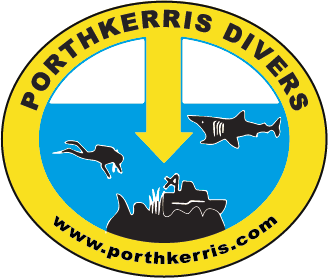Shore Diving
Porthkerris has one of the best shore dives in the UK. A must vist for both the experienced and novice diver.
The cove nestles under high cliffs, and is protected from all but East Winds. So in the summer, when the prevailing winds are occasionally very strong from the south – west, Porthkerris is generally flat calm.
The beach drops away quickly towards a fringing reef at the northern end of the cove, that breaks surface no more than a hundred metres offshore, even at high water. Behind these visible rocks, a submerged reef arcs out for a further two hundred metres or so, accessing depths of 18 to 20 metres, depending on the state of the tide. So you can explore everything from shallow inshore reefs to deeper waters all within a three hundred-metre swim. An ideal area for newly qualified Open Water Divers.
As you follow the reef the depth increases gradually from 6 metres to 12-15 metres depending on the tide. Getting below the kelp line reveals garlands of jewel anemones, tunicates, sea cucumbers and sponges.
Don’t ignore the sea bed as this is home to all sorts of bottom dwelling fish, crustaceans, tube worms, anemones, sea urchins and, in the spring and summer months, hordes of juvenile cuttlefish.
The reef is bisected by a number of cuts and gullies crying out to be explored although your first dive is best spent familiarising yourself with the topography and routes for your return.
Continue seaward until the big reef wall terminates on your right and you encounter some large individual rocks, which are the beginning of the reef running further out into deeper water. Here, again depending on the tide, you can either continue seaward on the low reef to deeper water and return the same way, or continue right along the seaward face of the reef. Beware of the currents during Spring Tides.
There is a section of wall, slightly undercut in places, that reaches 4-5 metres in height before the reef forms a series of steps and ledges towards the surface. Because this face is exposed to tidal current it is covered with filter-feeding deadmans fingers, jewel anemones and sponges, making it quite colourful especially in a torchlight beam.
Maximum depth here approaches 18-19 metres at high water. This part of the reef is home to several varieties of fish: marauding Pollack, the occasional bass, ballan and corkwing wrasse, cheeky cuckoo wrasse that peer right into your mask, and more unusual species such as red gurnard and John Dory.
Also do not be too surprised if you meet something bigger than yourself out in the bay during the summer. More often than not basking sharks cruise within a hundred metres of the beach and a pod of dolphins make regular visits so you can never tell what might turn up along with occasional seals looking for a "Playmate".
